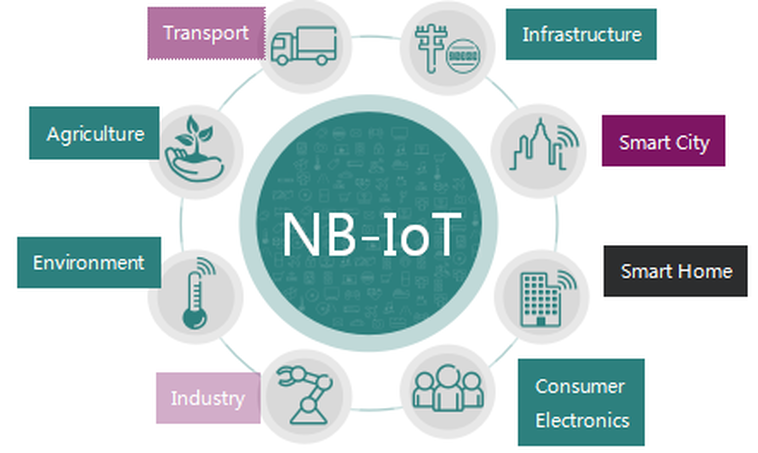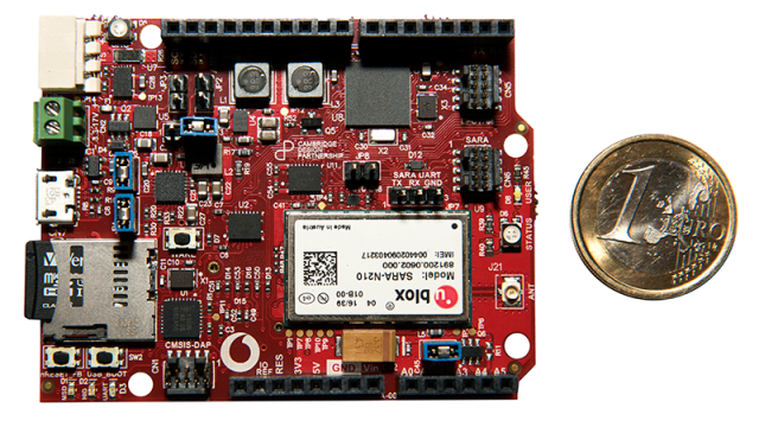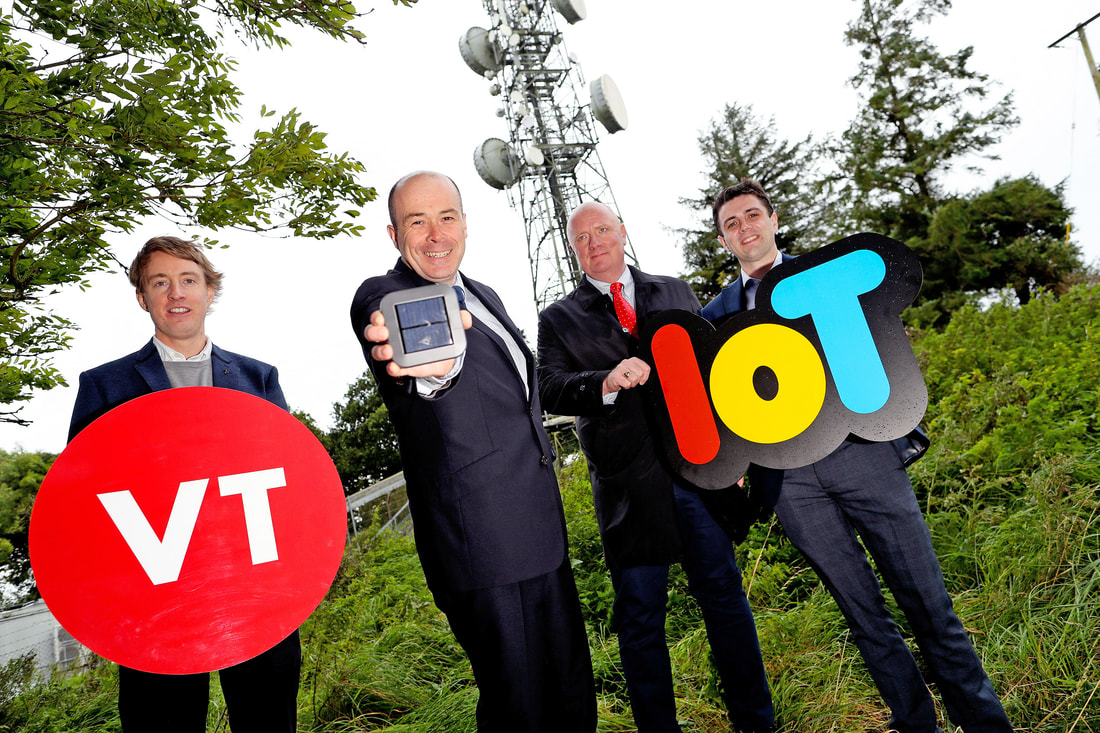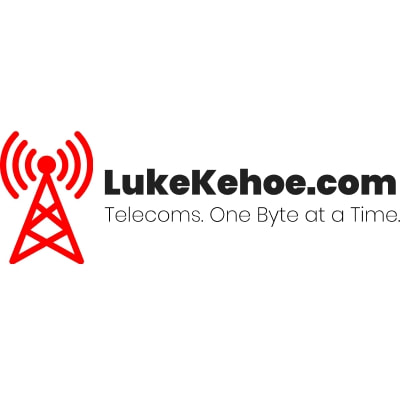NB-IoT Explained: The Technology that Vodafone hopes will connect everything.
As the Internet of Things continues to grow at a phenomenal pace, Vodafone wants a piece of the pie, prompting the launch of NB-IoT across Europe.
Published 03/08/18
As the idea of a society connected with the Internet of Things becomes more widespread, so too does the presence of low power wide area networks (LPWA). Such networks are designed specifically to meet the needs of IoT devices such as smart metres and trackers, needs which are a far cry from those exhibited by our smartphones. Simply put, using traditional cellular networks such as 4G LTE or 3G are not appropriate for an IoT Revolution. These networks are hindered by their design, consuming too much power and bearing too much cost. Plenty of people have recognised the amazing potential of IoT, and that's why we see a plethora of networks available for an IoT Revolution.
LTE M, Sigfox, LoRa, Cat-0 and Cat-1 are all networks designed for the Internet of Things, and all feature different advantages and disadvantages. In this article, I will briefly discuss the features of Narrowband-IoT (NB-IoT), the network that Vodafone hopes will connect everything around us. Unlike Sigfox, which you can read more about here, NB-IoT is a cellular-based IoT network that was defined by 3GPP (the group responsible for setting technical specifications for new cellular standards).
NB-IoT is being pursued by Vodafone, the second largest telecoms operator in the world, and the company has rolled out the IoT network in most markets where it operates in Europe, including Ireland. NB-IoT uses licensed spectrum, meaning Vodafone must pay ComReg for its use. Compared to Sigfox, NB-IoT is more complicated, as it uses traditional cellular networks. Unfortunately, NB-IoT has fallen victim to the spread of misinformation, so I feel that it is important to clear things up a little.
NB-IoT or LTE Cat NB-1 is designed to be implemented in one of three ways. It does not operate in the 4G LTE construct and uses 180KHz of spectrum. NB-IoT can be implemented on a single GSM carrier spectrum, or alongside a 4G LTE spectrum band. It may also be implemented in the guard band (the gap between frequency bands that prevents interference) if it is not possible to reduce the capacity of 4G LTE. NB-IoT can be activated on the RAN (Radio Access Network) by deploying a software upgrade on most base stations. This gives NB-IoT more flexibility over Sigfox or LoRa, and makes it easy for existing networks to roll out the technology.
LTE M, Sigfox, LoRa, Cat-0 and Cat-1 are all networks designed for the Internet of Things, and all feature different advantages and disadvantages. In this article, I will briefly discuss the features of Narrowband-IoT (NB-IoT), the network that Vodafone hopes will connect everything around us. Unlike Sigfox, which you can read more about here, NB-IoT is a cellular-based IoT network that was defined by 3GPP (the group responsible for setting technical specifications for new cellular standards).
NB-IoT is being pursued by Vodafone, the second largest telecoms operator in the world, and the company has rolled out the IoT network in most markets where it operates in Europe, including Ireland. NB-IoT uses licensed spectrum, meaning Vodafone must pay ComReg for its use. Compared to Sigfox, NB-IoT is more complicated, as it uses traditional cellular networks. Unfortunately, NB-IoT has fallen victim to the spread of misinformation, so I feel that it is important to clear things up a little.
NB-IoT or LTE Cat NB-1 is designed to be implemented in one of three ways. It does not operate in the 4G LTE construct and uses 180KHz of spectrum. NB-IoT can be implemented on a single GSM carrier spectrum, or alongside a 4G LTE spectrum band. It may also be implemented in the guard band (the gap between frequency bands that prevents interference) if it is not possible to reduce the capacity of 4G LTE. NB-IoT can be activated on the RAN (Radio Access Network) by deploying a software upgrade on most base stations. This gives NB-IoT more flexibility over Sigfox or LoRa, and makes it easy for existing networks to roll out the technology.
The Features of NB-IoT
Low Cost
NB-IoT provides a cost-effective approach of connecting sensors to the Internet. Components such as radio modules, PCBs and antennas are relatively inexpensive, and these prices will continue to fall as the uptake of the technology extrapolates. This feature of NB-IoT is replicated with the subscription service to the network, costing only a few euro each month. NB-IoT modules are expected to fall to as low as $5 dollars as the technology matures, but will remain more expensive than those connected to the Sigfox network. It also important to bear in mind that unlike with Sigfox, a SIM card is required with NB-IoT, adding to the cost.
For the network operator, such as Vodafone, the cost of implementing NB-IoT across their existing network is relatively inexpensive. Licensing fees have to be paid to the provider of equipment and software, like Huawei. Also, as mentioned, NB-IoT makes use of licensed spectrum which is expensive. If the resources are available, a rollout of NB-IoT should be relatively fast as networks can use their existing base stations rather than having to construct new ones. These points highlight the fact that NB-IoT is significantly more expensive to roll out than Sigfox, which uses unlicensed spectrum, and requires minimal capital and operational expenditure. Rolling out an NB-IoT network only makes sense for existing telecoms companies, it would be a mammoth task for a newcomer to successfully establish their own widespread NB-IoT network without agreeing to some form of infrastructure-sharing agreement with a bigger company.
Using NB-IoT for roaming across different countries doesn't make sense in many cases. As with cellular networks, prices vary wildly in each country depending on the operator, making it very difficult to predict costs when travelling. This is a major drawback that will hamper the use of the technology for logistics and other industries that move from country to country on a frequent basis. I hope that Vodafone, given its scale, will make efforts to solve this fragmentation and develop a consistent pricing structure across countries.
For the network operator, such as Vodafone, the cost of implementing NB-IoT across their existing network is relatively inexpensive. Licensing fees have to be paid to the provider of equipment and software, like Huawei. Also, as mentioned, NB-IoT makes use of licensed spectrum which is expensive. If the resources are available, a rollout of NB-IoT should be relatively fast as networks can use their existing base stations rather than having to construct new ones. These points highlight the fact that NB-IoT is significantly more expensive to roll out than Sigfox, which uses unlicensed spectrum, and requires minimal capital and operational expenditure. Rolling out an NB-IoT network only makes sense for existing telecoms companies, it would be a mammoth task for a newcomer to successfully establish their own widespread NB-IoT network without agreeing to some form of infrastructure-sharing agreement with a bigger company.
Using NB-IoT for roaming across different countries doesn't make sense in many cases. As with cellular networks, prices vary wildly in each country depending on the operator, making it very difficult to predict costs when travelling. This is a major drawback that will hamper the use of the technology for logistics and other industries that move from country to country on a frequent basis. I hope that Vodafone, given its scale, will make efforts to solve this fragmentation and develop a consistent pricing structure across countries.
Low Power Consumption
NB-IoT modules consume less power than their traditional cellular counterparts. This is thanks in part to the use of narrowband frequencies, and the fact that NB-IoT modules are in standby for most of their lifetime. Depending on the conditions, NB-IoT devices can last on battery power for several years. This is incredibly important for applications where long lifespans are needed, such as smart metres for water.
Unfortunately, the actual lifespan of devices connected to an NB-IoT network is difficult to predict, and the figures touted by companies are usually based on perfect conditions. As the signal quality and strength deteriorates, so too does the rate at which power is consumed. In this way, the further a device is from the base station, the shorter its battery life will be. This can become an issue if NB-IoT coverage is poor in the area where battery-powered sensors are being used. This phenomenon does not occur with Sigfox devices, making it much easier to predict power consumption than on NB-IoT networks.
NB-IoT will become more energy-efficient as the technology progresses, and that will enable more applications. However, the information spread by companies such as Vodafone about the battery life of NB-IoT devices needs to be clearer and based on a range of signal conditions, rather than just idyllic conditions that do not reflect real-world cases. While some sensors may last years on an NB-IoT network, others could die within a few weeks of deployment. These battery life issues will be mitigated as the coverage of NB-IoT is improved.
Unfortunately, the actual lifespan of devices connected to an NB-IoT network is difficult to predict, and the figures touted by companies are usually based on perfect conditions. As the signal quality and strength deteriorates, so too does the rate at which power is consumed. In this way, the further a device is from the base station, the shorter its battery life will be. This can become an issue if NB-IoT coverage is poor in the area where battery-powered sensors are being used. This phenomenon does not occur with Sigfox devices, making it much easier to predict power consumption than on NB-IoT networks.
NB-IoT will become more energy-efficient as the technology progresses, and that will enable more applications. However, the information spread by companies such as Vodafone about the battery life of NB-IoT devices needs to be clearer and based on a range of signal conditions, rather than just idyllic conditions that do not reflect real-world cases. While some sensors may last years on an NB-IoT network, others could die within a few weeks of deployment. These battery life issues will be mitigated as the coverage of NB-IoT is improved.
Excellent Coverage and Indoor Penetration
As NB-IoT uses narrowband spectrum, it provides excellent coverage, with the help of retransmissions and spreading. The link budgets are better because the bitrates are less, meaning the network can offer better indoor and underground penetration when there is a high density of base stations. NB-IoT utilises licensed spectrum, making it less susceptible to interference than other technologies which use unlicensed spectrum, delivering a high quality of service (QoS) for customers.
This is an important feature as many IoT devices are located underground, in rural areas, or surrounded by thick walls which have been traditionally difficult to penetrate with other cellular technologies. But as NB-IoT is a cellular technology, it does fall victim to some of the same limitations that 4G LTE does. Namely, an NB-IoT device must maintain a constant connection to a base station and exchange synchronisation messages. This makes it more difficult to meet the SLA (Service-level agreement) than with a network such as Sigfox as devices on this network broadcast three different messages at three different times on three different frequencies (time and frequency diversity) and are received by at least one base station (spatial diversity).
NB-IoT delivers low latency which can enable real-time monitoring when there is a need. The latency can be as low as 10 seconds, even in underground environments, making the chances of packet loss smaller.
This is an important feature as many IoT devices are located underground, in rural areas, or surrounded by thick walls which have been traditionally difficult to penetrate with other cellular technologies. But as NB-IoT is a cellular technology, it does fall victim to some of the same limitations that 4G LTE does. Namely, an NB-IoT device must maintain a constant connection to a base station and exchange synchronisation messages. This makes it more difficult to meet the SLA (Service-level agreement) than with a network such as Sigfox as devices on this network broadcast three different messages at three different times on three different frequencies (time and frequency diversity) and are received by at least one base station (spatial diversity).
NB-IoT delivers low latency which can enable real-time monitoring when there is a need. The latency can be as low as 10 seconds, even in underground environments, making the chances of packet loss smaller.
Faster Data Throughput than Sigfox or LoRa
A major advantage which NB-IoT has over Sigfox and LoRa is the availability of more bandwidth, with downlink rates of up to 235kbps (when deployed standalone). This allows for more bandwidth demanding applications in the future as our IoT sensors evolve. Furthermore, the greater bandwidth means NB-IoT can still be utilised at the cell-edge, whereas Sigfox and LoRa would be rendered useless due to the data transfer rate dropping close to zero. The greater bandwidth of NB-IoT can be put to use for tasks such as downloading OTA software updates on sensors, something that would be impossible using Sigfox or LoRa. Think about the importance of this in terms of ensuring the security of mission-critical sensors which need to receive security patches frequently.
Another massive advantage of NB-IoT is the lack of duty cycle restrictions found with technologies that use unlicensed spectrum such as Sigfox or LoRa. At 1% duty cycle maximum, the typical level, a Sigfox sensor can send up to 144 messages per 24-hour period (1.6KB). This limitation can become a problem if interference means the sensor must retransmit its message.
Another massive advantage of NB-IoT is the lack of duty cycle restrictions found with technologies that use unlicensed spectrum such as Sigfox or LoRa. At 1% duty cycle maximum, the typical level, a Sigfox sensor can send up to 144 messages per 24-hour period (1.6KB). This limitation can become a problem if interference means the sensor must retransmit its message.
Unparalleled Security
Regardless of the type or purpose of data transmitted by sensors, security is a critical feature that businesses will be on the lookout for. Just think about this, what if a hacker managed to remotely disable smoke detectors or alarms? NB-IoT inherits the features which have made 4G LTE very secure. Usually, It is difficult to secure low bandwidth devices that make up the Internet of Things. NB-IoT traffic is encrypted between the device and core network using "bank-grade encryption". A key built into an NB-IoT SIM during manufacture is used to authenticate the network and device. It is also used to generate frequently updated session keys for encrypting traffic between the device and deep within the core network. Sigfox does not encrypt traffic while in transit by default (it can be deployed by the customer or by paying for a subscription service) which doesn't make much of a difference for some applications but is critical in cases where sensitive data is being transmitted.
As NB-IoT is open source, vulnerabilities can be identified more easily and brought to the attention of manufacturers and networks before the flaw is exploited. Sigfox and LoRa use proprietary code, making it more difficult to scrutinise for vulnerabilities.
As NB-IoT is open source, vulnerabilities can be identified more easily and brought to the attention of manufacturers and networks before the flaw is exploited. Sigfox and LoRa use proprietary code, making it more difficult to scrutinise for vulnerabilities.
Conclusion: Supporting the IoT Revolution
NB-IoT stands out as a very promising technology that will support the IoT Revolution. As the technology has gained the backing of some of the most powerful companies in telecoms, you can be sure that it will bring sweeping changes to the way our society functions. It benefits from features such as low power consumption, unparalleled security, low cost and excellent coverage and indoor penetration.
However, for all its benefits, NB-IoT does have its own fair share of drawbacks. The technology is fragmented, with different networks operating on different bands in different regions. There is no clear pricing structure, a major disadvantage for applications that require inter-country travel. Both power consumption and unit costs remain higher than those with Sigfox, and that will always be the case. For some applications, these drawbacks will be meaningless, and that's the beauty of technology, there's always a multitude of options to choose from.
Going forward, we need to look for the facts about the technology, not what the marketing department decides to spin. There is too much misinformation and misunderstanding surrounding NB-IoT, and that will hold the technology back. However, it is clear that the world's second-largest telecoms giant is serious about this technology, it recently launched a portfolio of consumer IoT products called V by Vodafone, products that will increase the pervasiveness of IoT in people's everyday lives.
However, for all its benefits, NB-IoT does have its own fair share of drawbacks. The technology is fragmented, with different networks operating on different bands in different regions. There is no clear pricing structure, a major disadvantage for applications that require inter-country travel. Both power consumption and unit costs remain higher than those with Sigfox, and that will always be the case. For some applications, these drawbacks will be meaningless, and that's the beauty of technology, there's always a multitude of options to choose from.
Going forward, we need to look for the facts about the technology, not what the marketing department decides to spin. There is too much misinformation and misunderstanding surrounding NB-IoT, and that will hold the technology back. However, it is clear that the world's second-largest telecoms giant is serious about this technology, it recently launched a portfolio of consumer IoT products called V by Vodafone, products that will increase the pervasiveness of IoT in people's everyday lives.
The Power of Sigfox: Pioneering the IoT RevolutionA deep dive into the prospects of Sigfox, the network that wants to blur the divide between the physical and digital world.
|








